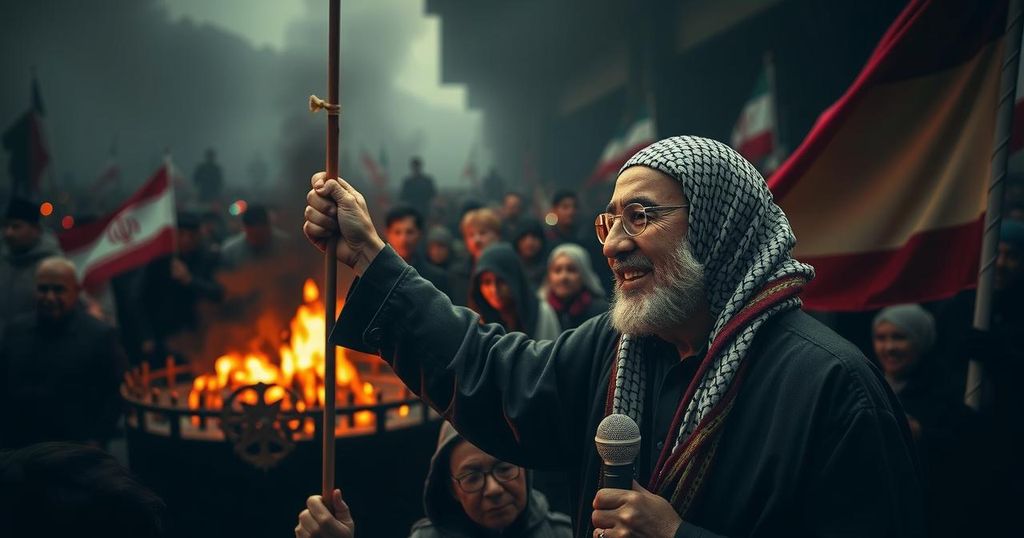Yahya Sinwar’s Death: Implications for Iran and the Axis of Resistance

The death of Yahya Sinwar, a significant figure in the axis of resistance and former head of Hamas, has disrupted the Iranian regime, drawing parallels to the fall of Nazi leadership in Berlin. Although hailed as a hero by Iranian officials, Sinwar was responsible for orchestrating violence and suffering in Gaza, including the massacre of Israeli civilians. His demise represents the fragility of authoritarian regimes, foreshadowing potential shifts in power dynamics within the region.
The recent death of Yahya Sinwar, a pivotal figure within the axis of resistance, has profoundly unsettled the Iranian regime. Sinwar was strategically positioned by Iran to launch extensive offensives against Israel, falling within the framework of the “Unity of Fronts” strategy targeting the perceived enemy. His death in Gaza starkly parallels the demise of Nazi leadership amid the ruins of Berlin, serving as a somber emblem of the inevitable disintegration that awaits regimes founded upon violence and tyranny, such as the Islamic Republic of Iran. Sinwar had earned the favor of Qasem Soleimani, the former chief of the Quds Force, and his successor, Esmail Qaani. His elevation to head Hamas followed the termination of Ismail Haniyeh, intended as a measure to prolong hostilities in Gaza while inflicting significant costs on Israeli military capabilities, economic stability, and social fabric. Nevertheless, his leadership role was abruptly curtailed. On October 16, Sinwar was observed by Israel Defense Forces (IDF) alongside two other Hamas members maneuvering between residences in Rafah. He subsequently sustained injuries during confrontations with Israeli troops, culminating in his death being confirmed the following day when IDF forces entered the premises. In the aftermath, various spokesmen for the Iranian regime heralded Sinwar’s death as an act of heroism in the struggle against Israel. Ayatollah Ali Khamenei hailed him as “the shining face of resistance,” while President Masoud Pezeshkian lauded him as a “tireless fighter who fought heroically until his last moment.” However, a closer examination of Sinwar’s final moments paints a contrasting portrait. Reports indicate that he was discovered attempting to navigate through buildings in Tel Sultan, seemingly in search of an escape route via tunnel systems in Rafah. Subsequent forensic analysis identified his DNA within the tunnel complex near the engagement site. An IDF drone captured imagery of Sinwar grappling with his injuries, hiding amidst rubble and displaying desperation as he unsuccessfully attempted to shield himself from impending threats. Portraying Sinwar as a hero diverges from the truth of his legacy. He orchestrated the callous murder of over 1,200 Israeli civilians, including women and children, on October 7. Renowned for unforgiving methods, he was labeled the “butcher of Khan Yunis,” reflecting both the terror he instilled within his ranks and among adversaries alike. Sinwar’s notorious cruelty extended to brutal acts of punishment against perceived traitors, reinforcing his grim reputation. His reign over Gaza ushered in devastation and despair, exacerbating poverty and hardship for the populace. Ironically, his demise elicited a relief response from segments of the Gaza Strip’s exhausted residents, a sentiment that echoes within the haunting parallels to the aftermath of Nazi rule in Germany. Among these dialogues, Iranian supporters of Hamas must reckon with the lessons drawn from the catastrophic end of the Third Reich, a fate which Sinwar’s legacy starkly foreshadows.
Yahya Sinwar’s leadership in Hamas positioned him as a key figure within the Iranian-supported resistance movement against Israel. He was specifically promoted to instigate significant military actions against Israel, reflective of Iran’s broader strategic objectives in the region. The context of his actions and their consequences profoundly affect both the political landscape in Gaza and the Iranian regime’s standing. Sinwar’s legacy is intertwined with acts of extreme violence and strategic military planning that led to significant loss of life, heightening tensions in an already volatile region. The reaction to his death from Iranian officials illustrates the intricate ties between Hamas and the Iranian regime, and how this relationship shapes regional dynamics.
The death of Yahya Sinwar signifies a critical juncture for both Hamas and the Iranian regime, revealing the fragility of structures built on violence and authoritarian rule. Sinwar’s legacy is marred by brutality and a violent agenda, leading to substantial suffering and conflict. His demise triggers reflections on broader consequences for Iran’s influence in the region and the potential for shifts in power dynamics among Palestinian factions. This event acts as a poignant reminder of the eventual downfall that awaits oppressive regimes as they grapple with their intrinsic violence and tyranny.
Original Source: www.jpost.com








